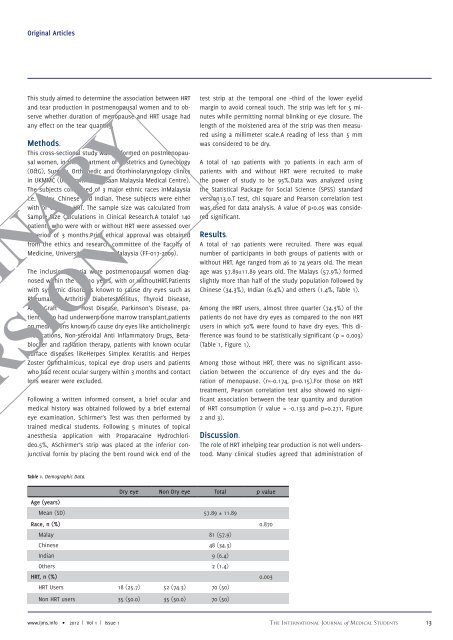Year 2012 - Volume 1 - Issue 1 - IJMS
Year 2012 - Volume 1 - Issue 1 - IJMS
Year 2012 - Volume 1 - Issue 1 - IJMS
You also want an ePaper? Increase the reach of your titles
YUMPU automatically turns print PDFs into web optimized ePapers that Google loves.
Original Articles<br />
This study aimed to determine the association between HRT<br />
and tear production in postmenopausal women and to observe<br />
whether duration of menopause and HRT usage had<br />
any effect on the tear quantity.<br />
Methods.<br />
This cross-sectional study was performed on postmenopausal<br />
women, in the department of Obstetrics and Gynecology<br />
(O&G), Surgery, Orthopedic and Otorhinolaryngology clinics<br />
in UKMMC (UniversitiKebangsaan Malaysia Medical Centre).<br />
The subjects comprised of 3 major ethnic races inMalaysia<br />
i.e. Malay, Chinese and Indian. These subjects were either<br />
with or without HRT. The sample size was calculated from<br />
Sample Size Calculations in Clinical Research.A totalof 140<br />
patients who were with or without HRT were assessed over<br />
a period of 3 months.Prior ethical approval was obtained<br />
from the ethics and research committee of the Faculty of<br />
Medicine, UniversitiKebangsaanMalaysia (FF-017-2009).<br />
NARY<br />
The inclusion criteria were postmenopausal women diagnosed<br />
within the last 10 years, with or withoutHRT.Patients<br />
with systemic disorders known to cause dry eyes such as<br />
Rheumatoid Arthritis, DiabetesMellitus, Thyroid Disease,<br />
AIDS, Graft Versus Host Disease, Parkinson’s Disease, patients<br />
who had underwent bone marrow transplant,patients<br />
on medications known to cause dry eyes like anticholinergic<br />
medications, Non-steroidal Anti Inflammatory Drugs, Betablocker<br />
and radiation therapy, patients with known ocular<br />
surface diseases likeHerpes Simplex Keratitis and Herpes<br />
Zoster Ophthalmicus, topical eye drop users and patients<br />
who had recent ocular surgery within 3 months and contact<br />
lens wearer were excluded.<br />
SION<br />
Following a written informed consent, a brief ocular and<br />
medical history was obtained followed by a brief external<br />
eye examination. Schirmer’s Test was then performed by<br />
trained medical students. Following 5 minutes of topical<br />
anesthesia application with Proparacaine Hydrochloride0.5%,<br />
ASchirmer’s strip was placed at the inferior conjunctival<br />
fornix by placing the bent round wick end of the<br />
Table 1. Demographic Data.<br />
Age (years)<br />
Dry eye Non Dry eye Total p value<br />
Mean (SD) 57.89 ± 11.89<br />
Race, n (%) 0.870<br />
Malay 81 (57.9)<br />
Chinese 48 (34.3)<br />
Indian 9 (6.4)<br />
Others 2 (1.4)<br />
HRT, n (%) 0.003<br />
HRT Users 18 (25.7) 52 (74.3) 70 (50)<br />
Non HRT users 35 (50.0) 35 (50.0) 70 (50)<br />
test strip at the temporal one –third of the lower eyelid<br />
margin to avoid corneal touch. The strip was left for 5 minutes<br />
while permitting normal blinking or eye closure. The<br />
length of the moistened area of the strip was then measured<br />
using a millimeter scale.A reading of less than 5 mm<br />
was considered to be dry.<br />
A total of 140 patients with 70 patients in each arm of<br />
patients with and without HRT were recruited to make<br />
the power of study to be 95%.Data was analyzed using<br />
the Statistical Package for Social Science (SPSS) standard<br />
version13.0.T test, chi square and Pearson correlation test<br />
was used for data analysis. A value of p


